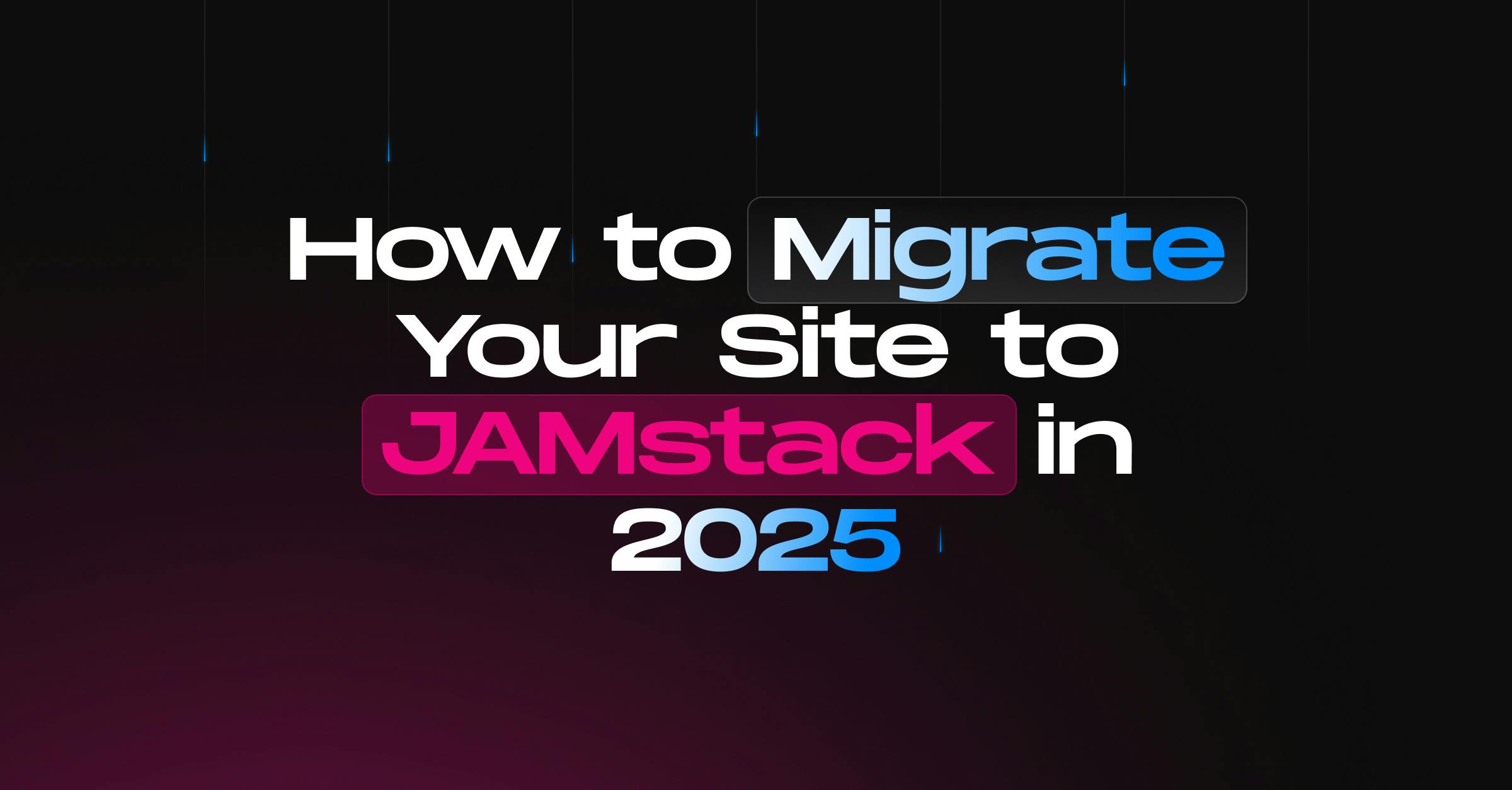June 20, 2025
Migrating to JAMstack in 2025: A Hands‑On Guide for Devs

Md. Saad

By 2025, JAMstack will have become the go‑to setup for modern, efficient websites. It now powers over 5.5 million sites across platforms like Netlify, and the ecosystem is valued at $8.6 billion. If your legacy app runs on WordPress, Drupal, or another monolith, switching to JAMstack might feel intimidating, but with a clear method, it’s entirely achievable (and worthwhile). This guide walks you through the full migration process, with practical steps and tested recommendations from real projects.
Whether you're rebuilding a marketing site or re-platforming a high-traffic blog, JAMstack offers the flexibility and performance modern teams need.
Why JAMstack Still Wins
- Blazing Performance: Pre-rendered files via CDNs yield millisecond response times; think 80 ms vs. 800 ms for older platforms.
- Rock‑Solid Security: Static sites remove many common vulnerabilities—no dynamic login endpoints to worry about.
- Easy Scaling: Manage sudden traffic spikes without complex backend setups—perfect for commerce, EdTech, and fintech.
- Developer Freedom: Pick the tools you love, best‑in‑class frontend, backendless services, and modern build tools.
In 2025, JAMstack will be more than static content; it will support Server‑Side Rendering (SSR), Incremental Static Regeneration (ISR), edge functions, middleware, and even AI integration.
Step by Step: Migrate with Confidence
1. Evaluate Your Current Setup
- Map your stack—frontend (WordPress/PHP, React/Node), database (MySQL, MongoDB), services (Stripe, Google Analytics).
- Decide what belongs in JAMstack. Blogs and marketing sites translate smoothly, while chat apps or live dashboards may need hybrid setups.
- Note any custom plugins or server‑side logic that needs replacement.
Pro tip: Make a migration checklist to track dependencies and blockers.
2. Pick the Right Tools
Choose from top-tier JAMstack tools based on your needs:
| Category | Option | Best For |
|---|---|---|
| Static Site Generators |
Next.js |
SSR, hybrid, edge functions |
| Static Site Generators |
Gatsby |
Content-heavy sites with GraphQL |
| Static Site Generators |
Hugo |
Fast build blogs |
| Static Site Generators |
Eleventy |
Lightweight, flexible builds |
| Static Site Generators |
Astro |
Minimal JS, modern component support |
| Headless CMS |
Sanity |
Real-time updates and schemas |
| Headless CMS |
Contentful |
Scalable, enterprise-grade |
| Headless CMS |
Strapi |
Developer-friendly, self-hosted |
| Hosting Platforms |
Netlify |
CI/CD, edge, AI features |
| Hosting Platforms |
Vercel |
Best for Next.js, serverless |
| Hosting Platforms |
Cloudflare Pages |
Global CDN, easy edge logic |
Pro tip: Build a small prototype using your top choices to test fit before committing.
3. Plan a Phased Migration
- Phase 1: Rebuild your front end with the chosen SSG; keep the original backend running.
- Phase 2: Replace backend features with APIs or serverless functions.
- Phase 3: Test each phase before production using staging + incremental deploys.
This method minimizes downtime and risk, especially on larger projects.
4. Export & Transform Data
- Use available tools to export content—WordPress includes WP Exporter, or you can write custom scrapers.
- Convert content to formats your new stack needs: markdown for Hugo, JSON for Sanity, etc.
Pro tip: Put transformed assets into Git, and use Git‑backed headless CMS where possible.
5. Build Your New Environment
- Start your SSG (e.g. npx create-next-app for Next.js).
- Hook it to your headless CMS via its API—GraphQL or REST.
- Optimize your build pipeline; large sites may benefit from splitting live content from archive builds.
If needed, add build tools (Webpack, Gulp) to speed things up.
6. Add Dynamic Features
- Authentication: Try GoTrue, Firebase Auth, or Auth0.
- E‑commerce: Use platforms like Shopify Hydrogen, Snipcart, or Medusa.
- Comments: Tools like Giscus or Utterances (GitHub‑based).
- Serverless logic: Use Netlify Functions or AWS Lambda.
Pro tip: Add edge functions for personalization or fast previews.
7. Test & Launch
- Run Lighthouse and WebPageTest to check performance.
- Secure your APIs; remove any stale backend access.
- Verify every user flow—forms, search, authentication—works in staging.
- Deploy via Netlify/Vercel with CI/CD and automatic SSL.
Pro tip: Keep a rollback plan ready during your first few deploys.
8. Monitor & Refine
- Track real‑world performance with analytics.
- Use ISR or incremental builds for faster updates.
- Maintain SEO hygiene—metadata, sitemaps, structured content, redirects.
- Routinely review build logs and performance data—optimization is ongoing.
What’s Hot in 2025
- AI & Edge Computing: Personalised content at CDN‑edge via Netlify and Vercel.
- Composable Architecture: Mix and match headless CMS, authentication, search, and commerce tools.
- Green Web: Pre-rendering + CDNs = lower carbon footprint.
- Next‑Gen Full‑Stack Frameworks: Next.js and similar tools make hybrid deployments a breeze.
Final Take
Migrating to JAMstack in 2025 doesn’t just modernize your stack—it boosts your performance, security, and scalability with a future-ready foundation. JAMstack fits a wide range of use cases from static sites to dynamic, AI-enhanced apps. The phased approach covered here helps minimize risk and gets you to live faster with less friction.
And if you’re looking for hands-on help, StaticMania has deep experience migrating legacy platforms to JAMstack. From initial planning to data transformation and post-launch optimization, our team has led successful transitions for global brands and startups alike.
Need a hand with your migration? We specialize in JAMstack migrations, SaaS SEO, Shopify, and e‑commerce SEO feel free to reach out anytime!
FAQs: Migrating to JAMstack in 2025
JAMstack (JavaScript, APIs, Markup) decouples the frontend from the backend, resulting in lightning-fast load times, stronger security, and easier scalability. With modern capabilities like SSR, ISR, and edge logic, it’s a future-ready architecture—especially appealing for content sites, e-commerce stores, and marketing platforms.
Migration time varies based on site complexity. A simple blog or marketing site can take a few weeks, while larger, dynamic sites (with custom functionality or plugins) may take several months. Using a phased approach—front end first, backend next, then dynamic features—helps you launch faster and test gradually.
- Static site generators like Next.js, Gatsby, Hugo, Eleventy, and Astro
- Headless CMS options include Sanity, Contentful, and Strapi
- Hosting platforms such as Netlify, Vercel, and Cloudflare Pages
Pairing these tools allows you to pick the best fit for your team’s stack, from SSR sites with Next.js to content-led builds with Gatsby or Hugo.
It depends. Complex personalisation logic can add overhead if everything builds statically. However, using edge functions or ISR (Incremental Static Regeneration) keeps build times efficient by handling dynamic elements at runtime only where needed.
Ensure key pages are either server-side rendered or statically pre-rendered with proper meta tags, structured schema, and dynamic sitemap updates. Tools like Next.js support SSR, while dynamic sitemap generation and canonical tags help search engines index your content correctly.
Yes. When implemented properly, JAMstack supports privacy-first architectures. Using first-party cookies, anonymised session tokens, and consent platforms like OneTrust ensures compliance with GDPR and CCPA while delivering personalised experiences at the edge.

